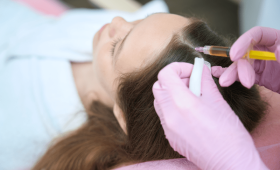Hair transplantation for women is a sensitive field with different dynamics than for men. Achieving successful results requires correct diagnosis, minimally invasive techniques, and high aesthetic ability. While Turkey maintains its global leadership in this field, below you can find the most frequently asked questions by women and the advantages Turkey offers.
Are Women Suitable Candidates For Hair Transplantation?
The vast majority of women are suitable candidates for hair transplantation, especially if their hair loss is genetic or localized due to scarring. However, unlike men, hair loss in women is often diffuse (widespread), requiring prior investigation of hormonal or medical causes. If the cause of the hair loss has been stabilized and there is sufficient density in the donor area, women can achieve successful results, particularly for lowering the hairline or adding density to sparse areas. Correct diagnosis and the use of minimally invasive (unshaven) techniques are vital for a successful outcome.
Why Are Female Hair Transplant Costs More Affordable In Turkey?
The main reason why female hair transplant costs in Turkey are lower than in Europe or the UK is the low general operating and living expenses. Clinic rents and personnel wages are much more affordable compared to Western countries. This allows centers in Turkey to offer more competitive prices without compromising quality (using the same technology and equipment). Moreover, the unshaven DHI technique, which is frequently used in female transplantation and takes longer, is offered in all-inclusive packages far below the prices in the West.
Which Techniques Provide The Most Successful Results For Female Hair Transplantation?
The techniques that generally provide the most successful results for female hair transplantation are the unshaven DHI (Direct Hair Implantation) and modified micro FUE methods. Since the entire hair should not be shaved in women, DHI technique stands out. DHI allows for dense implantation among existing hairs and the placement of follicles at the correct angle and direction. For a successful aesthetic result, expert teams select the technique based on the hair’s natural growth direction and density need, ensuring the result is unnoticeable.
Is Shaving Necessary For Female Hair Transplant?
In the vast majority of female hair transplant operations, shaving the entire hair is not necessary. This provides great comfort for female patients in terms of returning to social life after the operation. Usually, only a small part of the donor area (nape) is partially shaved (window shaving) so that it can be hidden under the existing hair. In some special cases or when using the DHI technique, direct implantation can be performed with no shaving at all, although this may increase the operation duration and cost.
How Is Hairline Design Different In Women?
Hairline design in women must be much softer, rounder, and less sharp than in men. In women, the goal is generally to increase density and fill the temporal areas rather than receding the frontal line. For a successful outcome, single, fine hair follicles should be used in the front line, and the line should include natural micro-irregularities. Turkish specialists are internationally recognized for creating highly aesthetically sensitive designs suitable for the female facial anatomy.
What Is The Average Number Of Grafts Required For Women?
The number of grafts required for women is generally lower than for men, depending on the type of hair loss. Women usually have the transplant done for the purpose of adding density (densification) to sparse areas among existing hairs, rather than covering completely bald areas. In this type of operation, generally 1,000 to 3,000 grafts are sufficient. If a much larger area needs transplantation, this number may increase, but preserving the donor area and the naturalness of the result is always a priority.
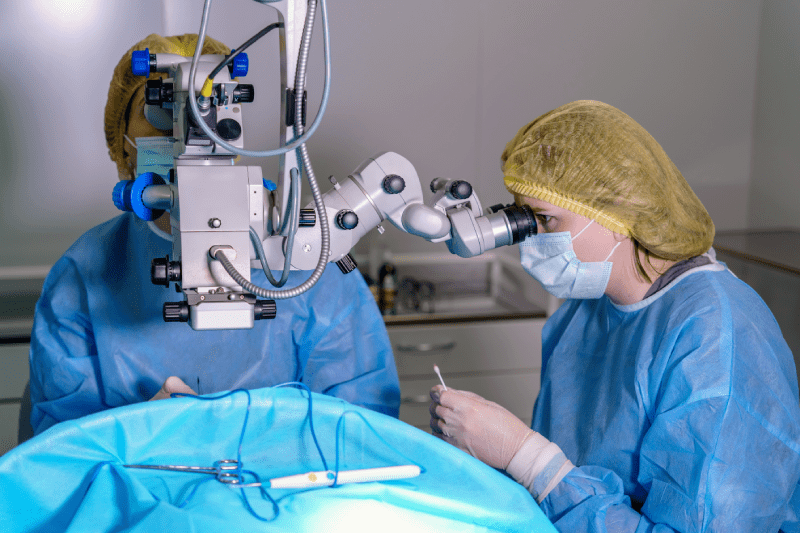
When Do Women Return To Their Social Lives After Hair Transplantation?
Since women usually undergo unshaven or partially shaven techniques, they can return to their social lives much faster compared to male patients. In the unshaven DHI method, healing is largely complete within 3 to 5 days after the transplant, and women can easily conceal the transplanted area using their existing hair. If a fully shaved procedure is done (which is rare), the 10-day period required for the scabs to fall off may need to be awaited.
How Are The Causes Of Hair Loss Diagnosed In Women?
Correct diagnosis of the cause of hair loss is vital before a hair transplant in women. This process usually involves detailed blood tests (iron, ferritin, thyroid hormones, Vitamin D) and hormonal evaluation. Hair loss can often be linked to an underlying medical cause such as telogen effluvium, thyroid disorders, or polycystic ovary syndrome. Transplants performed without treating these causes can fail, which is why expert centers mandate this preliminary diagnosis.
How Long Does It Take For The Hair Transplant Results To Fully Emerge?
The process for hair transplant results to fully settle and achieve a permanent, natural appearance requires a patient waiting period of 12 to 18 months, just as in men. After the initial shedding phase (shock loss), new hair typically begins to grow from the 4th month. However, it is important to wait close to 1 year for the hair follicles to fully thicken, mature, and reach their final density. Regular online follow-up during this period is critical for the success of the result.
Why Is Donor Area Quality So Important In Women?
Donor area quality is of great importance in women, especially since the goal is maximum density with a lower number of grafts. Hair in the donor area that is thick, healthy, and contains multiple grafts (more than one hair strand) directly affects the resulting density. Furthermore, it is critical that the donor area in women is not overly thinned (over-harvesting), as women generally do not cut their hair short, and sparseness in this area can be easily noticed aesthetically.
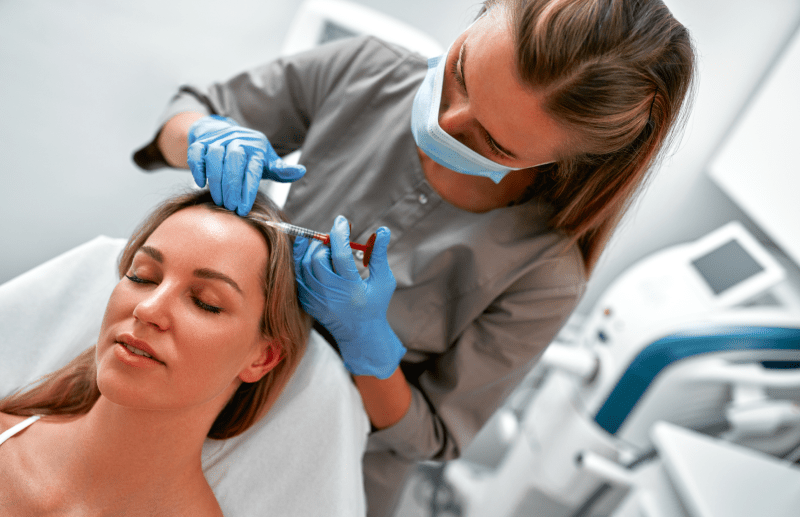
When Can Women Dye Their Hair After Hair Transplantation?
It is generally recommended that women wait at least 1 month before dyeing their hair after a hair transplant. The harsh chemicals found in hair dyes and bleaches can damage the newly implanted and still sensitive hair follicles and the healing skin, or increase the risk of infection. At the end of the first month, mild and ammonia-free hair dyes should be preferred. During this period, the recommended special shampoos and lotions should continue to be used to protect the scalp.
Why Are Women’s Hair Transplant Centers Popular in Istanbul?
Istanbul is the most popular city internationally for female hair transplantation because it hosts numerous specialized centers in this field. The unshaven DHI technique, which is common in women, and the most natural hairline designs have continually developed here due to the high volume of cases. The international patient flow has enabled the Istanbul teams to gain unique experience with different hair types and skin structures, which guarantees successful results.
Are Accommodation And Transfers Included In Packages For Women?
Yes, most female hair transplant centers in Turkey offer all-inclusive packages for the comfort of international patients. These packages typically include extra services such as accommodation in 4 or 5-star hotels, VIP transfers between the airport and the clinic. Special attention is paid to the sensitivity of female patients, aiming for a private and comfortable recovery process. This allows patients to focus entirely on their recovery rather than dealing with logistics.
Should Hormonal Treatment Be Continued After Hair Transplantation?
Hair transplantation does not solve the existing shedding problem; it only provides a permanent transplant of new hair. If the hair loss is caused by an underlying hormonal disorder (e.g., thyroid or iron deficiency), continuing hormonal treatment or supplements after the transplant is mandatory. These treatments are critical for slowing the shedding of existing, non-transplanted hairs and maintaining the general health of the hair follicles. This decision must be made under the supervision of a specialist doctor.
Will Scars Remain After Female Hair Transplantation?
Since female hair transplantation is usually performed with FUE or DHI techniques, no visible scarring remains in the donor area. These techniques do not result in a linear scar that requires stitches; only millimetric, small, round channels are opened. Given that very little area in the donor region is shaved (enough to be hidden) and healing is rapid, the existing hair completely covers the healed area. This allows female patients to wear their hair as they wish.
Can Eyebrow Transplant And Hair Transplant Be Done Simultaneously?
Yes, eyebrow transplant and hair transplant operations can be performed in the same session, provided there are enough grafts available from the donor area and the total operation time is not excessively long. This allows the patient to undergo a single recovery process and address both aesthetic needs in one trip. However, since eyebrow transplantation requires high precision (angle and direction), expert teams must prioritize the eyebrow transplant and select the finest and most suitable grafts for it.
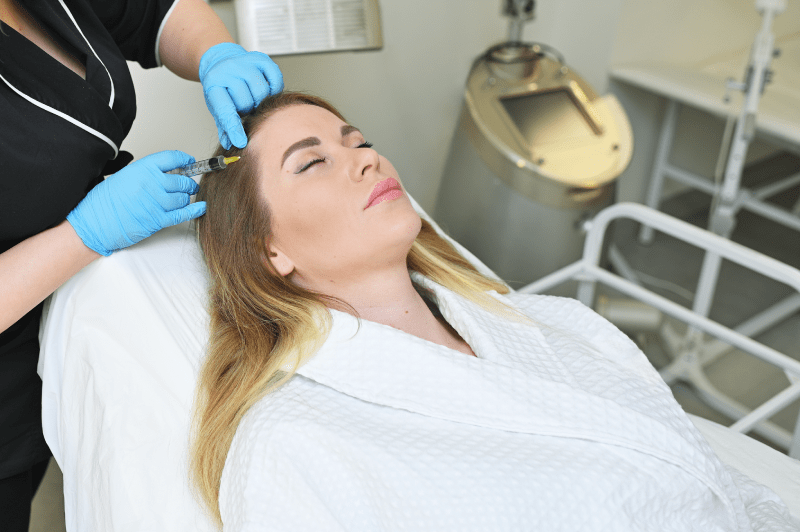
How Should Sun Protection Be Managed After Hair Transplantation?
Sun protection after a hair transplant is very important for women too, especially during the first 30 days. The transplanted area is extremely sensitive to direct sunlight, and sunburn can cause permanent damage to the roots. Female patients should use wide-brimmed, loose-fitting hats or scarves when going outside. While it is easy to conceal the transplanted area due to their long hair, avoiding direct contact is vital as UV rays can still pose a danger.
How Comfortable is Hair Transplantation for Women in Izmir?
Izmir offers a comfort that is calmer, more relaxing, and enhanced by the soothing atmosphere of the Aegean compared to Istanbul for those considering a female hair transplant. Centers in Izmir are known for their personalized services and particularly luxury boutique hotel accommodations. Patients can recover from the post-operative period more quickly and with less stress in the peaceful environment of the Aegean. This positively affects the patients’ recovery comfort and psychology.
When Is Sexual Intercourse Safe After Female Hair Transplantation?
It is generally recommended to wait 5 to 7 days for sexual intercourse after a hair transplant. Sexual activity can cause sweating by increasing body temperature and blood pressure. The increase in sweating and blood pressure can pose a risk to the newly implanted roots. The first 7 days are the critical period during which the implanted grafts adhere firmly to the skin; after this period, normal activities can be resumed, taking care not to apply pressure to the scalp.
Will There Be Swelling And Redness During The Recovery Period?
Yes, mild to moderate swelling (edema) and redness are quite common after a hair transplant. Swelling occurs due to the accumulation of local anesthesia and usually subsides naturally within the first 3-5 days. Redness, while varying from person to person, can last several weeks on sensitive skin. Cold compresses and anti-edema medications recommended by specialists are important steps that help minimize this condition.
What Is The Guarantee For Female Hair Transplantation?
Reliable centers in Turkey generally offer a written graft survival guarantee for female patients as well (usually 90% and above). This guarantee commits that the transplanted follicles will take root and grow at the specified rate. For the guarantee conditions to be valid, the patient has the obligation to refrain from smoking and alcohol and strictly adhere to post-operative care instructions. In case of failure, a free touch-up (correction) session may be offered.
What Are The Special Long-Term Follow-Up Services For Women?
Long-term follow-up services for female patients are generally conducted through online and photo consultation systems and are included free of charge in most packages. In this follow-up process, experts monitor the hair’s growth rate, densification, and the effect of hormonal balance on the hair. Furthermore, recommendations for supplements and treatments are provided against the risk of continued shedding of existing hair, which is common in women, making them critically important for the permanence of the result.

Are the clinics in Mugla and its surroundings reliable?
Although Mugla and its surroundings (Bodrum, Marmaris) are known for summer tourism, they have some reliable centers offering aesthetic and plastic surgery services. The reliability of the centers in these regions may not be as easily verifiable as the high-volume centers in Istanbul or Izmir. Therefore, when choosing a clinic in the Mugla region, it is advised to carefully research the international accreditation of the facility where the operation is performed and the team’s experience, particularly in female hair transplantation and DHI.
What Medications And Supplements Are Recommended After Hair Transplantation?
After a hair transplant, women are usually prescribed painkillers and antibiotics to prevent infection for a short period. In the long term, supplements like Biotin, Zinc, and Iron (based on blood test results) and topical solutions like Minoxidil may be recommended to slow hair loss and strengthen the roots. Since maintaining the success of female hair transplantation is closely related to the protection of existing hair, these supplements are very important.
Can Hair Transplantation be Combined with a Holiday in Kusadasi?
Kusadası is one of the popular tourist destinations in the Aegean Region and is a suitable option for those who want to combine hair transplantation with a holiday concept. However, it should be remembered that sun, sea, and pool should be strictly avoided for the first 15 days after the operation. Therefore, patients usually prefer to take a holiday before the operation or spend the recovery period resting in a comfortable hotel. Centers in Kusadası usually offer a combination of regional tourism and health services.
Are Special Psychological Support Services Available For Women?
Hair loss can cause more intense psychological stress and anxiety in women compared to men. For this reason, some large centers in Turkey offer psychological support or patient coordinator consultancy services for international patients. Organizations like Cure Holiday also help patients overcome this difficult period more easily by providing communication support to address their concerns about the process and keep their expectations realistic.
What to Consider When Choosing a Hair Transplant Center in Fethiye and Marmaris?
Although Fethiye and Marmaris are known for their beauty, they may not be as rich as Istanbul or Izmir in terms of high-volume specialized centers for hair transplantation. When choosing a center in these regions, attention should be paid to ensuring that the clinic is not just a tourist facility open during the summer months, that surgical operations are always performed in a fully equipped hospital environment, and that the team has a proven portfolio in female hair transplantation.
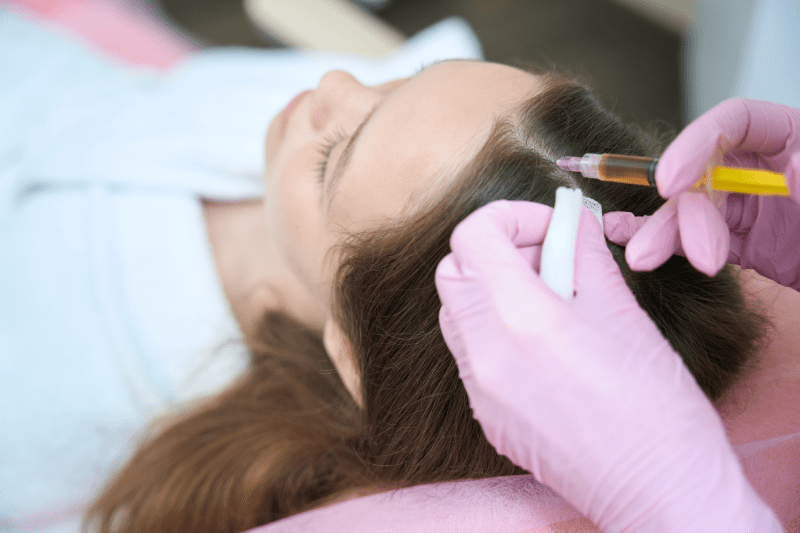
Which Season Is More Suitable For Female Hair Transplantation?
Hair transplantation can technically be performed in any season of the year. However, due to the necessity of sun protection during the recovery period, female patients generally prefer the autumn or winter months (October-March). Since sunlight is less intense during these seasons, protecting the sensitive area where the transplant was performed is easier, and this can accelerate the healing process. Wearing a hat or scarf is mandatory even in summer months.
How Is Travel And Accommodation Organized By Cure Holiday?
Cure Holiday manages all travel and accommodation logistics for female patients from A to Z. This service includes planning direct flights to Istanbul from the patient’s country, VIP welcome and transfer at the airport, accommodation in a luxury hotel, and scheduling clinic appointments. This ensures that patients experience a completely comfortable and safe process without dealing with logistics and can focus on post-operative rest.
How Long Should Smoking And Alcohol Consumption Be Stopped Before Hair Transplantation?
Smoking and alcohol consumption must be strictly stopped to prevent risking the success and recovery process of the hair transplant operation. Experts strongly recommend discontinuing alcohol and tobacco use at least 7 days before the operation. Smoking reduces the graft survival rate by hindering blood flow to the roots, while alcohol increases the risk of bleeding. This prohibition must continue for at least 14 days after the operation.
Why Are Centers In Istanbul Specialized In Revision Operations?
Centers in Istanbul have gained deep expertise in revision (correction) operations, which can also occur in women, thanks to their high volume of cases and international competition. Revision is complex because it involves correcting mistakes like wrong angles, unnatural hairlines, or low density. The experience of the Istanbul teams in treating thousands of cases from different ethnicities makes them the world’s most competent centers for revision.
Is There A Minimum Age Limit For Female Hair Transplantation?
While there is no legal minimum age limit for female hair transplantation, most specialists avoid operating on patients under the age of 18. The main reason for this is that the hair loss pattern and hormonal balance may not have fully stabilized before the age of 18. Transplants performed at a young age increase the risk of facing new shedding in later years. Therefore, it is essential to confirm the cause of the shedding and its permanence before deciding on a transplant.
What Is Done Under Warranty If Female Hair Transplantation Fails?
If female hair transplantation fails (lower-than-expected adherence or unnatural appearance), it is covered under the warranty. Reliable centers usually offer a free touch-up (correction) or additional session. This correction is typically planned 12-18 months after the initial operation (after the final result is visible), and Cure Holiday ensures that the patient’s entire process follow-up and communication support are provided to utilize the warranty right.
How Are The Aesthetic Approaches Of Clinics In Istanbul Evaluated?
The aesthetic approaches of clinics in Istanbul are evaluated by their ability to design a soft, rounded hairline suitable for the female facial anatomy. The best centers offer an artistic perspective beyond technique, aiming for perfect harmony between the eyebrows, temporal area, and hairline. Patients’ before/after photo portfolios should be examined, and the naturalness of the transplants done for female patients should be questioned in detail.
Why Is Cure Holiday The Most Reliable Guide For Female Hair Transplantation?
Cure Holiday directs patients, especially for sensitive aesthetic procedures like female hair transplantation, not to random clinics but to proven centers specialized in this field. We work with teams experienced in unshaven DHI and female aesthetics. Furthermore, we offer all-inclusive, transparent packages to ensure budget safety and handle all travel/accommodation logistics. This way, patients experience the best quality and most comfortable journey to achieve the results they desire.


